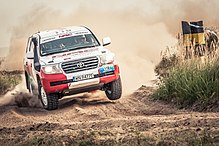In relation to motorsport, Group T2 is a set of technical specifications for series production cross-country cars used in off-road Cross-Country Rallying (also called Rally Raid). The group is governed by the Fédération Internationale de l'Automobile (FIA) and defined in appendix J, article 284 of its International Sporting Code.[1] The cars must use a bodyshell and apart from safety features such as a roll cage and upgraded suspension and wheels, must retain features of the series production car unlike the thoroughbred race prototypes in Group T1, which have more freedom surrounding the chassis build and other parts. The cars in T2 must be homologated with a series production build requirement of 1000 identical units.

History
editGroup T2 was first introduced in 1990 when the generic Group T, introduced the year before, was divided into four specific categories. Until 2002, FIA's T2 was for improved series production cross-country cars, with Group T1 being reserved for normal series production cars.[2] In 2003 for one year only, T2 became modified cross-country cars with no production requirement and being placed in Category II for competition cars. However the following year they were moved back to Category I production cars, essentially swapping to the modern arrangement, with T1 for modified competition cars and T2 for series production cars.. These cars have been competing in Baja Cross Country Rallies, Rally Raids and Marathon Rallies since their inception, including in the FIA World Cup for Cross Country Rallies.
Classes
editThere are no additional classes when competing in the FIA World Rally-Raid Championship, which includes the long established Dakar Rally in its inaugural season. Prior, T2 cars complying with the Dakar Rally's organiser ASO's rules were permitted in FIA events and cups.[3]
Cars
editHomologated cars as of 2023 include:
| Manufacturer | Model | Capacity | Début | End | Image |
|---|---|---|---|---|---|
| Isuzu | D-Max TFS-85 | 2999.3cc | 2005 | 2026 | |
| D-Max TFS-85H | 2999.3cc | 2007 | 2026 | ||
| D-Max TFS-85 | 2999.3cc | 2013 | 2027 | ||
| MU-X UCS85 | 2999.3cc | 2015 | 2027 | ||
| Nissan | Navara Double Cab D40 | 2488.5cc | 2007 | 2026 | |
| Pathfinder R51 | 2488.5cc | 2008 | 2026 | ||
| Patrol Y62 | 5569.6cc | 2014 | 2026 | ||
| Mitsubishi | Pajero Turbo Diesel V88W | 3200.5cc | 2007 | 2026 | |
| Toyota | Land Cruiser VDJ200 | 4461.2cc | 2008 | 2026 | |
| Land Cruiser KDJ155 | 2991.3cc | 2011 | 2026 | ||
| Land Cruiser GR Sport FJA300 | 3353.7 | 2022 | 2029 | ||
| Toyota | Hilux SRV | 2982.2cc | 2013 | 2026 | |
| Hilux SW4 SUV | 2982.2cc | 2013 | 2026 | ||
| Source:[4][5] | |||||
See also
edit- Cross-Country Cars
- Group T1 - prototype
- Group T2 - series production
- Lightweight Cross-Country Vehicles
- Group T3 - prototype
- Group T4 - series production side-by-side vehicles
- Cross-Country Trucks
- Group T5 - prototype and series production
References
edit- ^ "Specific regulations for Series Production Cross-Country Cars (Group T2)" (PDF).
- ^ "Appendix J to the International Sporting Code, 1990 (classification, definitions and specifications of cars)" (PDF).
- ^ "2022 CROSS-COUNTRY RALLY SPORTING REGULATIONS" (PDF).
- ^ "LISTE DES HOMOLOGATIONS / HOMOLOGATIONS LIST – 2022" (PDF).
- ^ "LISTE DES HOMOLOGATIONS / HOMOLOGATIONS LIST – 2023" (PDF).